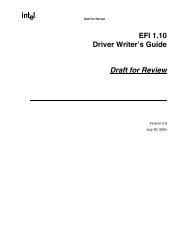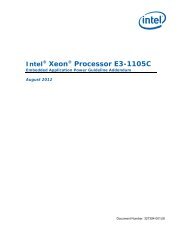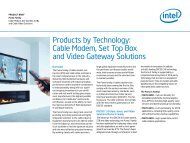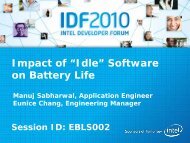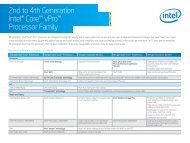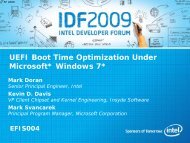Maintaining Information Security while Allowing Personal ... - Intel
Maintaining Information Security while Allowing Personal ... - Intel
Maintaining Information Security while Allowing Personal ... - Intel
You also want an ePaper? Increase the reach of your titles
YUMPU automatically turns print PDFs into web optimized ePapers that Google loves.
IT@<strong>Intel</strong> White Paper<br />
<strong>Intel</strong> IT<br />
IT Best Practices<br />
<strong>Information</strong> <strong>Security</strong> and Employee Productivity<br />
November 2010<br />
<strong>Maintaining</strong> <strong>Information</strong> <strong>Security</strong> <strong>while</strong> <strong>Allowing</strong><br />
<strong>Personal</strong> Hand-Held Devices in the Enterprise<br />
Executive Overview<br />
With safeguards in place to<br />
protect data and intellectual<br />
property, we are allowing<br />
employees to select the tools<br />
that suit their personal work<br />
styles and facilitate their job<br />
duties, improving employee<br />
productivity and job satisfaction.<br />
Rob Evered<br />
<strong>Information</strong> <strong>Security</strong> Specialist, <strong>Intel</strong> IT<br />
Jerzy Rub<br />
<strong>Information</strong> Risk & <strong>Security</strong> Manager, <strong>Intel</strong> IT<br />
<strong>Intel</strong> IT is actively integrating employee-owned hand-held devices into our<br />
enterprise environment. We have long recognized that the consumerization of IT—<br />
employees using their personal devices to access corporate data—is not a passing a<br />
workplace trend, so we worked closely with <strong>Intel</strong>’s Legal, <strong>Information</strong> <strong>Security</strong>, and<br />
Human Resources (HR) groups to enable a solution that aligns with our information<br />
security policy.<br />
In January 2010, we implemented a new<br />
program allowing employees to use their<br />
own hand-held devices on the job. Employee<br />
response was overwhelmingly positive, with<br />
more than 3,000 employees signing up in<br />
the first month. As of September 2010, our<br />
computing environment included more than<br />
20,000 hand-helds, and about 6,500 of<br />
these are employee-owned with access to<br />
corporate information. In July, we started a<br />
new program that allows personally owned<br />
tablets; we do not yet allow personally<br />
owned PCs, but are investigating that<br />
possibility for contract employees.<br />
To reach this point, we engaged in activities<br />
on several fronts:<br />
• We worked with <strong>Intel</strong> Legal and HR for<br />
more than a year to define and implement<br />
a personal device policy that meets <strong>Intel</strong>’s<br />
information security requirements.<br />
• We used social media to engage in dialogue<br />
with employees over a period of six months<br />
to understand their work styles and<br />
support needs.<br />
• We developed technical solutions, such as<br />
new authentication methods and device<br />
management policies, that help safeguard<br />
corporate information and intellectual property.<br />
• We provided training to users about<br />
information security and to IT Service Desk<br />
personnel about our personal device policy.<br />
By taking control of the trend and the<br />
technology in our environment, we have been<br />
able to circumvent many of the security issues<br />
that might have occurred if we simply ignored<br />
the issue or prohibited employees from using<br />
their own devices to accomplish some of their<br />
job duties.<br />
With safeguards in place to protect information<br />
and intellectual property, we are allowing<br />
employees to select the tools that suit their<br />
personal work styles and facilitate their job<br />
duties, improving employee productivity and<br />
job satisfaction.
IT@<strong>Intel</strong> White Paper<br />
<strong>Maintaining</strong> <strong>Information</strong> <strong>Security</strong> <strong>while</strong> <strong>Allowing</strong> <strong>Personal</strong> Hand-Held Devices in the Enterprise<br />
Contents<br />
Executive Overview............................. 1<br />
Business Challenge.............................. 2<br />
The Case for <strong>Personal</strong> Devices<br />
in the Enterprise................................ 2<br />
Balancing User Demand and<br />
<strong>Information</strong> <strong>Security</strong> ........................ 3<br />
Solution................................................... 3<br />
<strong>Security</strong> Challenges .......................... 4<br />
Designing a <strong>Security</strong>-conscious<br />
IT Consumerization Policy................ 4<br />
Training Users and<br />
Service Desk Personnel.................... 6<br />
Technical Considerations.................. 6<br />
Results ................................................ 7<br />
Future Plans....................................... 8<br />
Conclusion.............................................. 8<br />
Acronyms................................................ 8<br />
IT@INTEL<br />
The IT@<strong>Intel</strong> program connects IT<br />
professionals around the world with their<br />
peers inside our organization – sharing<br />
lessons learned, methods and strategies.<br />
Our goal is simple: Share <strong>Intel</strong> IT best<br />
practices that create business value and<br />
make IT a competitive advantage. Visit<br />
us today at www.intel.com/IT or contact<br />
your local <strong>Intel</strong> representative if you’d<br />
like to learn more.<br />
BUSINESS CHALLENGE<br />
Like many enterprise IT organizations,<br />
<strong>Intel</strong> IT prohibited the use of personal<br />
hand-held devices in our environment.<br />
With the consumerization of IT, we face<br />
the daunting challenge of enabling<br />
employees’ desire to access corporate<br />
information using an array of personal<br />
hand-held devices.<br />
Ten years ago, <strong>Intel</strong> employees came to work<br />
to use great technology. Now, with the battery<br />
of consumer devices available, they often<br />
have better PCs and printers at home than<br />
they do at work. User expectations have also<br />
changed: We no longer need to provide basic<br />
computer and software training—users already<br />
have experience, often using platforms that<br />
we don’t have—and the Internet has become<br />
accessible from more places than ever before.<br />
The Case for <strong>Personal</strong><br />
Devices in the Enterprise<br />
<strong>Intel</strong>’s highly mobile workforce wants to<br />
take advantage of the most up-to-date<br />
systems, services, and capabilities to do their<br />
jobs, typically using hand-held devices as<br />
companion devices to extend the usefulness<br />
of their corporate-owned mobile business<br />
PCs. This allows them to access information<br />
easily from home or on the road.<br />
For example, many users want to synchronize<br />
their <strong>Intel</strong> calendars with a third-party webbased<br />
calendar utility so they can use their<br />
personal devices to access their work calendars<br />
from anywhere. They are motivated by the<br />
desire to get their jobs done in a manner that is<br />
easy, efficient, and most productive.<br />
Employees often don’t consider the information<br />
security issues raised by such a practice;<br />
however, for <strong>Intel</strong> IT, information security<br />
is critically important. We investigated the<br />
possibility of continuing our policy prohibiting<br />
all personal devices, but analysis showed that<br />
enforcing the policy would have consumed<br />
millions of dollars in software and support<br />
and would have negatively impacted users’<br />
productivity.<br />
Such an approach would have required <strong>Intel</strong><br />
IT to verify every application before allowing<br />
a user to install it—which alone would take<br />
away much flexibility from our highly technical,<br />
often specialized 80,000-user base. We also<br />
would have needed to significantly modify<br />
<strong>Intel</strong> culture and user expectations, deploy<br />
new lab networks, and install large amounts<br />
of new hardware and networking equipment.<br />
Since the use of personal devices was<br />
beginning to accelerate at <strong>Intel</strong>, our policy<br />
needed to change to accommodate it. We<br />
chose to embrace the consumerization of IT,<br />
recognizing that the trend offered significant<br />
potential benefits to both users and to IT:<br />
• Increased productivity. Users can<br />
choose devices that fit their work styles<br />
and personal preferences—resulting in<br />
increased productivity and flexibility.<br />
• Greater manageability. By offering a<br />
program that users can adopt, we are<br />
aware of what they are doing and can<br />
offer services that influence their behavior.<br />
This provides a clear understanding of our<br />
risk level so we can actively manage it.<br />
• Enhanced business continuity. If a user’s<br />
mobile business PC is nonfunctional, a<br />
personal hand-held device provides at<br />
least a partial backup, enabling the user<br />
to continue to work productively.<br />
• Loss prevention. Internal data indicates<br />
that users tend to take better care of their<br />
own belongings and tend to lose personal<br />
devices less frequently than corporateowned<br />
devices—which actually enhances<br />
information security.<br />
• Greater security. Rather than ignore<br />
the consumerization of IT, we can increase<br />
information security by taking control of<br />
the trend and guiding it.<br />
We challenged our organization to find a way to<br />
allow at least some form of IT consumerization<br />
<strong>while</strong> meeting <strong>Intel</strong>’s information security and<br />
privacy requirements.<br />
2 www.intel.com/IT
<strong>Maintaining</strong> <strong>Information</strong> <strong>Security</strong> <strong>while</strong> <strong>Allowing</strong> <strong>Personal</strong> Hand-Held Devices in the Enterprise<br />
IT@<strong>Intel</strong> White Paper<br />
Balancing User Demand<br />
and <strong>Information</strong> <strong>Security</strong><br />
With each new generation of technology,<br />
<strong>Intel</strong> IT must develop ways to help keep<br />
information secure. The challenge is to<br />
develop a policy that maximizes both user<br />
demand and information security to the<br />
greatest extent possible.<br />
In general, when users first adopt a new<br />
technology, we do not incur excessive<br />
support costs because security threats<br />
are minimal (see Figure 1). At the point<br />
where user demand peaks, the technology<br />
becomes expensive to support because<br />
security threats increase as more people gain<br />
experience with the technology and start to<br />
attack it. At that point, represented by point<br />
B in the figure, we need to allocate resources<br />
to secure the technology. The return on<br />
investment, however, is less than ideal<br />
because user demand for that technology<br />
begins to taper off, shown at point C, as<br />
other new technology becomes available.<br />
We have found that adopting a technology<br />
at point A, where both user demand and<br />
information security are both relatively high,<br />
is the best approach.<br />
SOLUTION<br />
Recognizing the potential benefits of the<br />
consumerization of IT to both employees<br />
and to IT, about three years ago we began<br />
to identify the unique security challenges<br />
this workplace trend poses, investigate<br />
user behavior, and define the requirements<br />
of an IT consumerization policy.<br />
These tasks involved close collaboration with<br />
<strong>Intel</strong> Legal and Human Resources (HR). We<br />
addressed some information security risks<br />
using technology, some by legal contract,<br />
and others with training designed to change<br />
behavior, empower users, and let them have<br />
responsibility for keeping current.<br />
The foundation for the consumerization of<br />
IT was laid 20 years ago, with the advent of<br />
the Internet, e-mail, and the world-wide web.<br />
Figure 2 illustrates this process, culminating<br />
with our phased approach to embracing at<br />
least some personal devices in the enterprise.<br />
We now have a policy in place that supports<br />
users’ needs for mobility and flexibility by<br />
allowing personally owned hand-held devices<br />
in the enterprise and is capable of allowing<br />
other personally owned devices in the future.<br />
A<br />
B<br />
C<br />
+<br />
–<br />
New Technology Adoption Cycle<br />
Users abandon the old technology and<br />
adopt the new.<br />
Many information security issues and high user<br />
demand; security costs rise.<br />
Users lose interest as competitive edge dwindles,<br />
but information security is stable.<br />
A<br />
B<br />
C<br />
Time<br />
Cost<br />
<strong>Information</strong><br />
<strong>Security</strong><br />
User<br />
Demand<br />
Figure 1. We have found it is best to adopt<br />
new technology at Point A, where user<br />
demand is still high but information security<br />
risk is still acceptable.<br />
Early 1990s<br />
E-mail and Web<br />
browsing add complexity<br />
to keeping corporate<br />
information safe<br />
Late 1990s<br />
<strong>Personal</strong> digital<br />
assistants (PDAs) arrive<br />
to help with personal<br />
planning<br />
Early 2000s<br />
Arrival of e-mail-capable PDAs<br />
Mid 2000s<br />
Third-party Web services<br />
for use with hand-held<br />
devices<br />
2007<br />
First smartphone<br />
appears on the market<br />
2008<br />
IT consumerization<br />
discussions begin in<br />
earnest at <strong>Intel</strong><br />
Early 2009<br />
We use social media<br />
to gather employee<br />
requirements for<br />
acceptable use of<br />
hand-held devices<br />
Late 2009<br />
We draft and approve a<br />
consumerization policy<br />
Late 2010<br />
More than 6,500<br />
employee-owned<br />
hand-held devices<br />
in use at <strong>Intel</strong><br />
Figure 2. Responding to a 20-year trend toward the consumerization of IT, we broke the development of our policy into stages; the entire effort took<br />
more than 18 months.<br />
www.intel.com/IT 3
IT@<strong>Intel</strong> White Paper<br />
<strong>Maintaining</strong> <strong>Information</strong> <strong>Security</strong> <strong>while</strong> <strong>Allowing</strong> <strong>Personal</strong> Hand-Held Devices in the Enterprise<br />
<strong>Security</strong> Challenges<br />
It is relatively easy to verify and enforce<br />
which applications are running on<br />
corporate-owned hand-held devices. With<br />
personal devices, this process is not so<br />
straightforward because employees have<br />
the right to install any applications they<br />
choose. However, we have identified<br />
certain minimum security specifications for<br />
hand-held devices that provide a level of<br />
Mobile Business PCs<br />
or Thin Clients<br />
At <strong>Intel</strong>, we have standardized on mobile<br />
business PCs, complemented by handheld<br />
devices such as smartphones and<br />
tablets—corporate- or employee-owned.<br />
This solution enhances employee<br />
productivity without compromising<br />
information security.<br />
We have not found that the thin client<br />
computing model, which centrally stores<br />
information and allows access to that<br />
information only from specific devices,<br />
is a foolproof way to protect corporate<br />
information.<br />
Although thin clients are appropriate<br />
for certain limited applications, in<br />
general we feel they limit user mobility,<br />
productivity, and creativity. Also, many<br />
of the perceived security enhancements<br />
associated with thin clients need to be<br />
viewed with caution. At <strong>Intel</strong>, we found<br />
that many of the information security<br />
risks merely moved—they didn’t disappear.<br />
For example, thin clients usually don’t<br />
include the same level of information<br />
security protection as mobile business<br />
PCs, yet they can still connect to the<br />
Internet and export information, putting<br />
that information at risk. Therefore, the<br />
loss of productivity that came with<br />
using thin clients was for little or no gain.<br />
information security that allows us to test,<br />
control, update, disconnect, remote wipe, and<br />
enforce policy:<br />
• Two-factor authentication required<br />
to push e-mail<br />
• Secure storage using encryption<br />
• <strong>Security</strong> policy setting and restrictions<br />
• Secure information transmittal<br />
to and from <strong>Intel</strong><br />
• Remote wipe capability<br />
• Some firewall and Intrusion Detection<br />
System (IDS) capabilities on the<br />
server side of the connection<br />
• Patch management and enforcement<br />
software for security rules<br />
• The ability to check for viruses from<br />
the server side of the connection,<br />
although the device itself may not<br />
have anti-virus software<br />
In the case of anti-virus software, we<br />
analyzed virus attacks on <strong>Intel</strong> mobile devices<br />
and found that very few targeted corporate<br />
information—most either sent text messages<br />
or attacked the user’s phone book. Although<br />
we do expect malware incidents to increase<br />
over time, the current threat level to actual<br />
corporate information is low.<br />
We also provide guidance for configuring<br />
software installed on the personal device,<br />
as well as a standard set of application<br />
installations.<br />
Designing a <strong>Security</strong>-conscious<br />
IT Consumerization Policy<br />
In designing a policy that would allow<br />
personal hand-held devices to access<br />
corporate information, we first needed to<br />
know how employees were already using<br />
personal devices, why they were using<br />
them, and what they expected from <strong>Intel</strong> IT.<br />
We then worked with <strong>Intel</strong> Legal and HR<br />
to address their legitimate concerns about<br />
allowing personal hand-helds to access<br />
corporate information. Once we crafted our<br />
policy, we needed to train our Service Desk<br />
personnel and employees on how to comply<br />
with the policy.<br />
FINDING OUT WHAT USERS WANT<br />
It quickly became evident that only users<br />
themselves know the answers to questions<br />
about preferences and behaviors. We decided<br />
to engage with employees directly through<br />
social computing—a blog—to openly discuss<br />
the creation of <strong>Intel</strong> IT’s consumerization<br />
policy. We met with resistance from <strong>Intel</strong><br />
Legal and HR because they understandably<br />
felt that discussing policy in an unconstrained<br />
environment like a blog might allow any<br />
responses to be perceived as policy itself. We<br />
needed to set clear expectations in all our<br />
communications that <strong>Intel</strong> IT was not making<br />
promises or firm statements about policy.<br />
Rather than letting this carry a negative<br />
tone, we were conversational and honest, as<br />
illustrated by the following example:<br />
“Over the next month we will be posting<br />
questions about how you believe <strong>Intel</strong><br />
should handle the consumerization issue.<br />
NOTE: This is an experiment—<strong>Intel</strong> has never<br />
opened up policy development discussions<br />
directly with employees. So be kind. Or be<br />
brutal, we can take it.<br />
Your feedback will be read by experts and<br />
decision-makers and may inform a future<br />
consumerization policy. Then again, it might<br />
be ignored altogether, no offense. J”<br />
When designing the blog, we engaged a<br />
communications specialist to help write<br />
the questions with user behavior in mind. It<br />
was important to craft questions in a way<br />
that would elicit meaningful responses. A<br />
sampling of the high-level questions we<br />
asked included:<br />
• Why do you want to use your own device(s)<br />
for work<br />
• What would you give up to use your device<br />
for work<br />
4 www.intel.com/IT
<strong>Maintaining</strong> <strong>Information</strong> <strong>Security</strong> <strong>while</strong> <strong>Allowing</strong> <strong>Personal</strong> Hand-Held Devices in the Enterprise<br />
IT@<strong>Intel</strong> White Paper<br />
• What does your personal device do that helps<br />
you work<br />
• Would you increase security habits for more<br />
device freedom More paranoia, please<br />
Many of our questions sought similar kinds<br />
of information from employees. Asking<br />
which applications people need for work and<br />
what functionality they need might seem<br />
redundant, but people interpret these two<br />
questions differently and provide different<br />
responses—which helped create a broad<br />
picture of usage patterns and preferences.<br />
In this particular example, applications allude<br />
to functionality but also reveal very specific<br />
solutions, <strong>while</strong> functionality confirms the<br />
overall preference or perceived need for a<br />
general task like calendaring or e-mail.<br />
Participation in this dialogue underscored users’<br />
desire to use personal devices to perform their<br />
jobs: More than 8,000 employees responded.<br />
In fact, user response was so enthusiastic and<br />
informative that we extended the lifespan of<br />
the blog from one month to six months.<br />
Sometimes users’ responses to our questions<br />
shed new light on assumptions we had made<br />
about how people worked. For example, two<br />
sales representatives, with essentially the same<br />
job responsibilities, had very different device<br />
preferences. One was adamant that he needed<br />
a device that could download applications,<br />
allow him to check e-mail, and show locations<br />
of airport lounges and wireless hotspots. His<br />
counterpart complained about having to use a<br />
device with too many extraneous features—he<br />
simply wanted a mobile phone that could make<br />
calls and had long battery life.<br />
GETTING SUPPORT FROM INTEL<br />
LEGAL AND HUMAN RESOURCES<br />
Developing an IT consumerization policy<br />
required support from <strong>Intel</strong> Legal and HR.<br />
Their concerns included policy validation and<br />
enforcement, e-Discovery, and audits and<br />
investigations.<br />
Because of these concerns, they monitored<br />
the blog closely, and we incorporated their<br />
feedback into our interactions with users. We<br />
took this opportunity to educate Legal and<br />
HR about the reality of IT consumerization<br />
and the potential benefits—as well as the<br />
potential risks—it posed for <strong>Intel</strong>. Collaboration<br />
allowed us to align our goals and solutions,<br />
and share the very positive user response to<br />
the concept of allowing personal hand-helds<br />
in the enterprise environment.<br />
CRAFTING AN END-USER LICENSE<br />
AGREEMENT (EULA)<br />
The result of our policy development activities<br />
is an end-user license agreement (EULA) that<br />
addresses information security through policy.<br />
In reality, it is not a new policy at all—rather, it<br />
aligns the use of personal assets for business<br />
purposes to our existing terms and conditions<br />
of employment so that users can anticipate<br />
common policies.<br />
The EULA gives users clear instructions on<br />
what they can and can’t do with a device.<br />
For example, the section on data storage<br />
and backup states:<br />
“Pursuant to the <strong>Intel</strong> Code of Conduct,<br />
you have the responsibility to ensure<br />
that the <strong>Intel</strong> Data in your possession is<br />
managed and protected. This means that<br />
you may be required to install encryption<br />
solutions and are not allowed to give<br />
non-<strong>Intel</strong> employees unlocked access to<br />
the device. Where any <strong>Intel</strong> Data resides<br />
on your device, you should only back it<br />
up to an <strong>Intel</strong> owned device.”<br />
Currently, our policy allows only personally<br />
owned hand-held devices, such as<br />
smartphones and tablets, as well as USB<br />
sticks for mass storage and some devices<br />
owned by business partners. However, we<br />
tried to make the EULA general enough<br />
that it would serve for virtually any type of<br />
personally owned device, even though the<br />
use of some of these, such as home PCs,<br />
are not yet allowed at <strong>Intel</strong>.<br />
After two years of development and<br />
modification, we now have one EULA that<br />
covers both personal and corporate devices, is<br />
not limited to specific applications, and is able to<br />
accommodate future developments for at least<br />
six months. We review the EULA each quarter to<br />
make sure that, as the technology and demands<br />
from users change, the legal protection provided<br />
by the EULA remains up to date. Users re-sign<br />
the EULA when they move to new technology.<br />
Of the more than 6,500 <strong>Intel</strong> employees who<br />
asked to use personally owned hand-held<br />
devices, only about 50 refused to sign the<br />
EULA. This reaction underscores the need for<br />
employee training and communication, because<br />
these employees wouldn’t have been signing<br />
anything new at all. Employees who do not<br />
sign the EULA cannot use personal devices<br />
to access corporate information.<br />
In addition to addressing what is and is not<br />
allowed, the EULA accommodates Legal and<br />
HR issues.<br />
Privacy Concerns<br />
Working with <strong>Intel</strong> Legal required us to<br />
define of the terms “corporate information,”<br />
“employee-owned data,” and “personal data.”<br />
• Corporate information is data or<br />
intellectual property owned by <strong>Intel</strong>.<br />
• Employee-owned data is data the<br />
employee owns, such as a to-do list<br />
or a collection of recipes.<br />
• <strong>Personal</strong> data is data controlled by<br />
privacy legislation, such as home address,<br />
medical data, and so on.<br />
We try to eliminate the commingling of<br />
personal and corporate information whenever<br />
possible, but often the technology does not<br />
support this effort. For example, personal and<br />
corporate information may intersect on calendar<br />
applications. Because users’ personal data is<br />
often mixed with corporate data on hand-held<br />
devices, users need to understand that, in the<br />
case of an investigation, we may confiscate<br />
their device and may see their personal data.<br />
www.intel.com/IT 5
IT@<strong>Intel</strong> White Paper<br />
<strong>Maintaining</strong> <strong>Information</strong> <strong>Security</strong> <strong>while</strong> <strong>Allowing</strong> <strong>Personal</strong> Hand-Held Devices in the Enterprise<br />
HR Concerns<br />
It is important that workers be compensated<br />
for their time spent working. Our EULA<br />
specifically addresses this issue:<br />
“Non-exempt employees who check their<br />
work e-mails outside of regular working<br />
hours are performing compensable work<br />
and must report this work time on their<br />
time cards. Non-exempt employees may<br />
not elect to work and not report their time.<br />
If a non-exempt employee believes that<br />
he/she is not being properly compensated<br />
for time worked, or believes that he/<br />
she is being pressured to perform work<br />
without reporting the time, this should<br />
be immediately reported to HR Legal or<br />
through the <strong>Intel</strong> Ethics reporting website.”<br />
eDiscovery Issues<br />
We expected eDiscovery to be a challenge,<br />
but it ended up being a fairly easy issue<br />
to address. As long as we don’t introduce<br />
local applications that generate data on<br />
the devices, the only connection between<br />
hand-held devices and the company is e-mail.<br />
Therefore, we can perform all eDiscovery on<br />
our e-mail servers.<br />
We did learn that employees create content<br />
in unique ways; for example, they might<br />
snap a photo of a white board and send it<br />
to colleagues in an e-mail message. We are<br />
able to capture this information on the e-mail<br />
server. Where information is located and what<br />
copies are on the devices is mostly controlled<br />
by policy and auditing.<br />
Collecting corporate information from devices<br />
that we don’t own can create challenges. We<br />
do not allow corporate information on devices<br />
that has not been synchronized elsewhere.<br />
We also added a clause to the EULA that<br />
informed users that they were subject to<br />
legal hold.<br />
“When placed on legal hold, you must<br />
surrender your device if requested to do<br />
so. All files on your device may need to<br />
be copied, and relevant files may be used<br />
in an <strong>Intel</strong> legal matter. By participating<br />
in this program, you agree to allow <strong>Intel</strong><br />
Legal to review and copy information<br />
on your device at any time <strong>Intel</strong> Legal<br />
determines it is necessary.<br />
Employees subject to a Legal Event Hold<br />
Notice may have restrictions on which<br />
services they are able to use. It’s your<br />
responsibility to understand from the IT<br />
eDiscovery team what services you are<br />
allowed to have on your device.”<br />
Investigation and Audit Changes<br />
Users agree in the EULA that <strong>Intel</strong> can<br />
investigate their personal device. However,<br />
with the advent of personal devices in<br />
the enterprise, our investigations team<br />
needed to work differently. Compared to<br />
investigating a corporate-owned device, it is<br />
much more difficult to investigate a personal<br />
device without the user being aware of<br />
the investigation. Therefore, we carefully<br />
defined what actions would necessitate us<br />
confiscating and investigating a personal<br />
device, and we try to package and release<br />
services in such a way that we won’t ever<br />
need to investigate the device.<br />
Training Users and<br />
Service Desk Personnel<br />
Simply developing a policy is not enough. We<br />
found that we needed to train users about<br />
what the policy means and how to protect<br />
information on their devices.<br />
For example, during our conversation with<br />
users on the blog, we learned that only<br />
about a third of them would decline to loan<br />
a personal device to a family member—even<br />
though the device had <strong>Intel</strong> information<br />
stored on it. Educating users about the risks<br />
such behavior poses to corporate information<br />
has the potential to enhance information<br />
security through behavior modification.<br />
We also discovered that IT Service Desk<br />
personnel required training to adequately<br />
answer users’ questions about the EULA, so<br />
that they don’t accidentally invalidate parts of<br />
it by giving the wrong answers. For example,<br />
if a user has a question about what form of<br />
monitoring <strong>Intel</strong> IT is performing on personal<br />
devices, Service Desk personnel must be<br />
careful not to give a response that could<br />
legally hamper <strong>Intel</strong>’s decision to monitor<br />
personal devices in the future. Frequently<br />
asked questions (FAQs) provide this type of<br />
training for our Service Desk employees and<br />
end users.<br />
Technical Considerations<br />
One of the biggest technical challenges to<br />
implementing our policy involved firewall<br />
authentication. With IT-managed systems,<br />
authentication uses two factors: something<br />
you know—a password—and something you<br />
have—a registered mobile business PC. But<br />
when the device is unknown, you are left<br />
with only one authentication criterion.<br />
Therefore, one of the interesting challenges<br />
of allowing personal devices in the enterprise<br />
is how to use information on the device to<br />
authenticate to the network, without that<br />
information belonging to the user. If the<br />
employee owns the piece of information<br />
used to authenticate to the network, we<br />
would have no grounds for disciplinary action<br />
if the user chooses to move his or her data<br />
to a different device to get access to the<br />
network. For example, the International<br />
Mobile Equipment Identity (IMEI) number on<br />
a mobile device belongs to the user if they<br />
6 www.intel.com/IT
<strong>Maintaining</strong> <strong>Information</strong> <strong>Security</strong> <strong>while</strong> <strong>Allowing</strong> <strong>Personal</strong> Hand-Held Devices in the Enterprise<br />
IT@<strong>Intel</strong> White Paper<br />
own the hardware, so we cannot use that<br />
to authenticate the device.<br />
To address this issue, we now send a text<br />
message to a predefined phone number,<br />
and that text message becomes the user’s<br />
password. In this scenario, the phone number<br />
is the “must-have” authentication factor,<br />
and the text message is the “must-know”<br />
authentication factor.<br />
Device management also poses challenges,<br />
because one solution doesn’t fit all devices<br />
and applications. We have designed our device<br />
management policy with the expectation<br />
that a device will be lost or stolen. Therefore,<br />
we expect it to be able to protect itself in a<br />
hostile attack. This means that the device<br />
is encrypted, can self-wipe with a number<br />
of wrong password attempts, and we can<br />
remotely wipe the device. Our personal device<br />
policy requires users to have controls in place<br />
prior to any loss.<br />
Also, some services need greater levels of<br />
security than others. For example, the system<br />
for booking a conference room doesn’t need<br />
the high level of security required by the sales<br />
database. Therefore, the room booking system<br />
can reside on a device over which we have less<br />
management control. We developed a tiered<br />
management system, which is illustrated in<br />
Figure 3.<br />
Results<br />
Our policy of allowing personally owned handheld<br />
devices in the enterprise has been in<br />
effect for about a year. Three thousand <strong>Intel</strong><br />
employees signed up for the program in the first<br />
month; to date, the <strong>Intel</strong> environment includes<br />
more than 20,000 hand-helds, 6,500 of which<br />
are personally owned by <strong>Intel</strong> employees. In July<br />
2010, we started a new program that allows<br />
personally owned tablets.<br />
We have been able to achieve these results<br />
using a three-pronged approach:<br />
• The EULA enumerates exactly what<br />
employees can and cannot do with a<br />
personally owned device, in language<br />
they can understand.<br />
• Technical solutions, such as new authentication<br />
methods, help safeguard information.<br />
• Training users about information security<br />
has helped improve the way they use<br />
personal devices, such as not letting family<br />
members or friends borrow a device that<br />
can access corporate information.<br />
This approach has allowed us to successfully<br />
accommodate personally owned handheld<br />
devices in our infrastructure without<br />
compromising our information security standards.<br />
Level of Access to Data and Services<br />
Typical Available Services<br />
Public Applications<br />
Corporate data on public servers<br />
Slightly Confidential<br />
Based on knowing the device belongs to<br />
an employee.<br />
Basic<br />
The least permissive level of access to<br />
corporate data.<br />
Intermediate<br />
Targeted line-of-business (LOB) or<br />
collaboration applications.<br />
Managed Equivalent<br />
The most permissive level of access to<br />
corporate data.<br />
• Stock<br />
• Internet<br />
(Pass Through/Site Filtering)<br />
• Travel<br />
• Expense<br />
• Voice over IP<br />
• Payroll<br />
• Pay Stub<br />
• Booking Teleconferences<br />
• Computer Reservations System<br />
• Calendaring<br />
• Contacts<br />
• Filtered E-Mail<br />
• Targeted LOB Applications<br />
• Intranet (Restricted)<br />
• E-Mail with Attachments<br />
• Job-specific Applications<br />
• General Applications<br />
• Intranet<br />
• Network Shared Drives<br />
• Backup and Recovery<br />
• Collaboration<br />
Public Applications<br />
Slightly Confidential<br />
Basic<br />
Intermediate<br />
Managed<br />
Equivalent<br />
Increasing access to applications and data<br />
with enhanced information security capabilities<br />
Figure 3. A tiered approach to device management lets us match the required level of management to the sensitivity of the information and application.<br />
www.intel.com/IT 7
We have seen a significant increase in<br />
productivity, measured by number of e-mail<br />
messages sent from a personal device and<br />
“time back” reports. We have also experienced a<br />
significant reduction in unauthorized devices on<br />
our network—currently, less than 0.5 percent—<br />
because we are enabling more devices with a<br />
sufficient level of security enforcement.<br />
Future Plans<br />
Although they are companion devices and in<br />
no way replace our employees’ mobile business<br />
PCs, hand-held devices comprise a significant<br />
part of <strong>Intel</strong>’s IT infrastructure. We are funded<br />
to deliver more user capability and more device<br />
management capability, so personal devices<br />
will be managed just like a laptop.<br />
Our manageability team is working on a new<br />
management console, which will feature<br />
improved reporting and security controls. We<br />
anticipate installing this new management<br />
system by the end of 2010.<br />
Through pilot projects, we are investigating<br />
several usage and support models for<br />
hand-held devices, both corporate- and<br />
employee-owned:<br />
• Use a corporate device and push e-mail<br />
from the supplier.<br />
• Use a low-cost device, either corporateowned<br />
or personal, and push e-mail from<br />
<strong>Intel</strong> IT servers.<br />
• Allow any device, using a portal for connectivity,<br />
with no offline information allowed.<br />
We also have a team that is improving access<br />
to applications from hand-held devices. For<br />
example, we will soon provide access to<br />
<strong>Intel</strong>’s intranet through personally owned<br />
hand-held devices. We are also investigating<br />
allowing employees to use popular social<br />
media applications to find and contact other<br />
<strong>Intel</strong> employees, as they have indicated they<br />
prefer this method to using <strong>Intel</strong>’s internal<br />
employee directory.<br />
CONCLUSION<br />
The consumerization of IT is a significant<br />
workplace trend <strong>Intel</strong> IT has been actively<br />
investigating for three years. We have<br />
established a comprehensive information<br />
security policy, trained users and Service<br />
Desk personnel about that policy, and<br />
developed technical solutions that meet<br />
our information security requirements.<br />
These accomplishments enable <strong>Intel</strong> IT<br />
to take advantage of the benefits of IT<br />
consumerization without putting our<br />
corporate data at risk.<br />
For us to successfully accommodate<br />
employees’ desire to use personal devices<br />
in the enterprise, it was important that we<br />
proactively anticipated the trend instead<br />
of ignoring it. In our dialogues with other<br />
companies, we found that many of them<br />
lost control of their environments by simply<br />
doing nothing. Our success also hinges on<br />
an even-handed approach to developing<br />
policy, where each instance of personal<br />
device usage is treated consistently; it<br />
would be difficult to take action if one<br />
employee did something if that thing is<br />
common practice.<br />
Now, our highly mobile users can use either<br />
their own or a corporate-owned hand-held<br />
device as a companion to their mobile<br />
business PC. Because employees with similar<br />
responsibilities have different preferences,<br />
allowing them to use the hand-held devices<br />
that best suit their work styles increases<br />
productivity and job satisfaction.<br />
For more information on<br />
<strong>Intel</strong> IT best practices,<br />
visit www.intel.com/it.<br />
ACRONYMS<br />
EULA<br />
FAQ<br />
HR<br />
IDS<br />
IMEI<br />
LOB<br />
PDA<br />
end-user license agreement<br />
frequently asked question<br />
human resources<br />
Intrusion Detection System<br />
International Mobile<br />
Equipment Identity<br />
line-of-business<br />
personal digital assistant<br />
This paper is for informational purposes only. THIS DOCUMENT IS<br />
PROVIDED “AS IS” WITH NO WARRANTIES WHATSOEVER, INCLUDING<br />
ANY WARRANTY OF MERCHANTABILITY, NONINFRINGEMENT, FITNESS<br />
FOR ANY PARTICULAR PURPOSE, OR ANY WARRANTY OTHERWISE<br />
ARISING OUT OF ANY PROPOSAL, SPECIFICATION OR SAMPLE. <strong>Intel</strong><br />
disclaims all liability, including liability for infringement of any proprietary<br />
rights, relating to use of information in this specification. No license, express<br />
or implied, by estoppel or otherwise, to any intellectual property rights is<br />
granted herein.<br />
<strong>Intel</strong> and the <strong>Intel</strong> logo are trademarks of <strong>Intel</strong> Corporation in the U.S. and other<br />
countries.<br />
* Other names and brands may be claimed as the property of others.<br />
Copyright © 2010 <strong>Intel</strong> Corporation. All rights reserved.<br />
1110/IPKA/KC/PDF<br />
Please Recycle<br />
323956-001US



